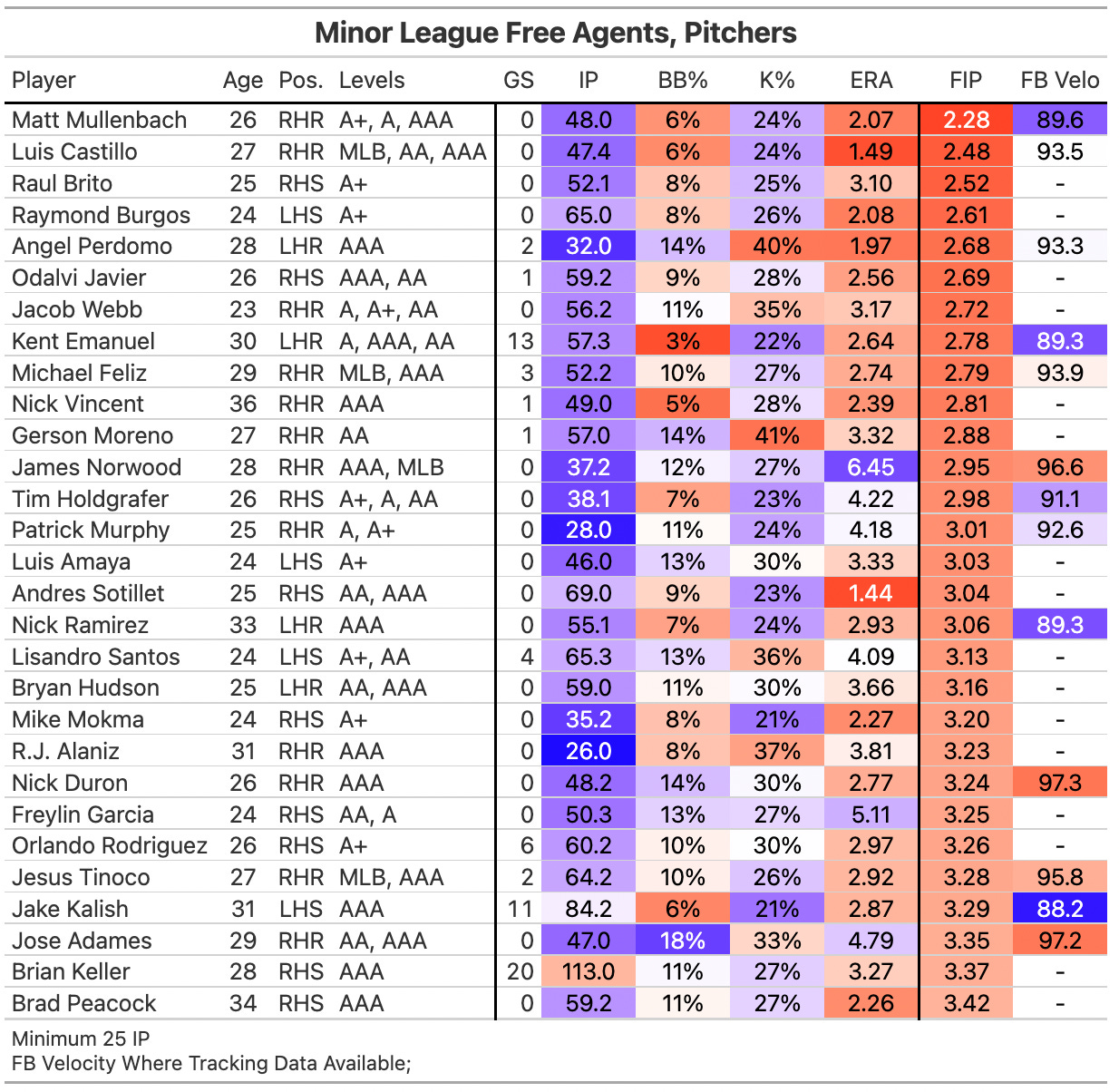The Minor League Free Agent List, Part II
A look at the available pitchers in the 2022-2023 minor league free agent class
Although there were some big name signings in free agency yesterday, we are going to talk about the lesser discussed part of free agency — minor league free agency. In case you missed last week’s primer, you can find it here. In that post we reviewed the minor league free agency process and the list of position players available this offseason. Today we’ll take a closer look at the 2022-2023 minor league free agent pitching class.
As we mentioned in our post last week focusing on position players, these signings are generally pretty low-risk for organizations. Clubs always need depth, and minor league free agency is one way to potentially add to that depth if you think a player has untapped potential or a fixable flaw.
Important disclaimer: This list came out a few weeks ago, so some of these players may have already signed. We did our best to remove these players and make the list as accurate as possible, but if there are omissions or mistakes, please let us know.
Every offseason the league puts out a list of declared minor league free agents. So although there are major league free agents who will sign minor league deals, those aren’t the players we are looking at today.
Before we look at a few tables, here’s a plot of each minor league free agent pitcher’s strikeout rate by walk rate (min. 25 IP). This gives us a nice overview of what we are working with here.
We are going to sort the list in a few different ways, but we’ll start by ranking the top 30 pitchers by FIP. More often than not the minor league free agent list will mostly be filled with relievers — that’s certainly the case here. We kept the position designation how it was recorded on the MiFA list, but in a lot of cases there are pitchers who are labeled as starters who didn’t start any games in 2022. For example, Luis Amaya, a left-hander who pitched in the White Sox organization last season, is listed as a starter but made 34 total appearances in High-A — all in relief.
Also, keep in mind that these are results across all levels and leagues without any adjustments. Ball-tracking data was only available last season in the PCL, FSL, and select ballparks in the International League — so when you see missing velocity data that’s the reason. More on that later.
There are a few potentially interesting arms here. Angel Perdomo is a massive 6’8 left-hander who struck out 40% of the batters he faced last season. Perdomo started the year in the Brewers organization but was designated for assignment and claimed by the Rays in July. Although he doesn’t possess above-average velocity, he seems to hide the ball well out of his delivery. This is likely something the Rays picked up on, as they are one of the clubs that measures deception through an “occlusion score” metric. This is typically measured as the percentage of time a pitcher hides the ball from the hitter’s field of vision — the longer the pitcher hides the ball, the less time the hitter has continuous visibility of the ball. His 6’8 frame also gives him well above-average extension. Hiding the ball for a long time and then releasing it closer to the hitter likely makes Perdomo’s 93-95 mph fastball seem more like it’s in the upper 90s. Minor league free agents typically don’t come without some warts — Perdomo struggled to throw strikes consistently in 2022 and walked 14% of the batters he faced. He also had some injury issues that limited his innings last season.
Punching Tickets…Highest K%
Like Perdomo, Gerson Moreno misses a lot of bats but struggled with handing out free passes. Moreno spent the entire 2022 season pitching at Double-A Erie (DET), where he posted a 3.32 ERA (2.88 FIP) across 57 innings of relief. Nick Duron closed out some games for Triple-A Lehigh Valley (PHI) last year and features an upper 90s heater. He struck out 30% of the batters he faced, but struggled with walks. Unlike Perdomo, Duron’s fastball didn’t produce an above-average whiff rate last season, perhaps because of it’s shape and lack of deception. However, Duron did feature a hard slider that got a lot of swing and misses.
How About the Hardest Throwers?
Okay, huge grain of salt here. As we mentioned earlier, we don’t have tracking data for every pitch in the minor leagues. For some pitchers who spent the entire season in the PCL or FSL, we have a mostly complete dataset. For others, we might only have a handful of pitches.
Keep reading with a 7-day free trial
Subscribe to Down on the Farm to keep reading this post and get 7 days of free access to the full post archives.






